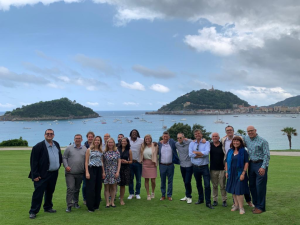Europe needs a solution to its crisis that will be accepted by its citizens. The South African model may be the answer.
By Bruce Ackerman and Miguel Maduro
Article published in The Guardian (October 3, 2012)
A spectre is haunting Europe. The memory of the 2005 national referendums rejecting the EU constitution has led political leaders to respond to the current crisis with emergency measures that don’t require popular approval. But longer-term solutions demand democratic legitimation.
The commission president, José Manuel Barroso, has gone so far as to call for a federation of nation states. Germany’s Guido Westerwelle, together with eight other foreign ministers, recently proposed fundamental reforms that might lead to a two-speed Europe – so long as a qualified majority of member states approved, their new treaty would bind them even if the other states do not go along. Such sweeping revisions can’t be achieved without popular consent.
Direct democracy is a risky business. Europe should not repeat the organisational mistakes that contributed to the debacle of 2005. The constitutional convention then produced a 350-page text written in legalistic language that mystified ordinary voters. Worse still, nothing special was done to encourage citizens to deliberate seriously on the fateful choice before them. Little wonder that national debates were largely dominated by the petty politics of the moment.
This time around, Europe should follow the example of South Africa‘s successful three-stage experiment in constitutional creation. During the first stage, participants simply tried to hammer out a statement of basic principles. Only later did they follow through with a long legalistic text elaborating the new social contract. Finally, it was up to South Africa’s constitutional court to confirm that the long-form legalisms conformed to the initial principles.
To put this sequence in European terms, the project should follow current treaties by organising a convention representing national and European parliaments, heads of state and governments, and the European commission. This body would focus on formulating readily comprehensible constitutional principles – which could then be revised by an intergovernmental conference.
This statement, for example, would set out the broad powers granted the union, but not a detailed list of competences; it would establish principles of representation in European bodies, but not elaborate voting rules. Following the recent proposal by the foreign ministers, it would also say how many EU members must ratify before the final treaty springs into operation between the consenting parties.
Phase one ends with each member state accepting or rejecting the statement of principles – by referendum or parliament, depending on the particular constitution. The straightforward character of the principles will be especially important in countries such as France (certainly) and Germany (probably) that will take the direct democracy route.
Nationalist opponents could no longer denounce an impenetrable treaty as part of a vast, Eurocratic conspiracy. Voters will confront their choices in no-nonsense terms. They may vote yes or no, but they are less likely to succumb to populist demagogy. The focus on principles will also help countries debate the need to amend their national constitutions (as may well be the case in Germany).
When referendums take place, citizens will also vote for national representatives to the second-stage convention that hammers out the final text. Since rival candidates will take different positions on the statement of principles, their debate will help voters better understand the basic issues raised by the referendum. If the citizenry votes yes, the popular selection of delegates will create another democratic link to the final document, further enhancing its legitimacy.
The second convention won’t be free to abuse its popular mandate by departing from the fundamental principles. It will instead submit its work-product to a special court that will guarantee compliance. The president of the European court of justice should preside over a tribunal containing the presiding judge of the highest court of each of the member states. This tribunal would guarantee the conformity of the final text to the constitutional principles affirmed by the voters. This final judicial check should give the new constitutional treaty sufficient legitimacy to go into effect without another round of member-state ratifications. It will also reduce the risk of future legal challenges against the reconstructed EU before national courts.
Europe is facing a historic choice. Political leaders can’t guarantee a successful outcome. But they have the high responsibility to design a system that will pose the key questions in a manner allowing a fruitful and deliberate democratic decision. Our three-stage procedure could come to a conclusion within a reasonable time and provide a strong democratic foundation for a union equipped to confront the challenges of the 21st century.
Bruce Ackerman is professor of law and political science at Yale. Miguel Maduro is a former Advocate General at the European Court of Justice. He is now a professor at the European University Institute and a visiting professor at Yale Law School.



